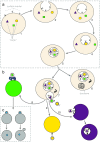Exosomes as a Nanodelivery System: a Key to the Future of Neuromedicine?
- PMID: 25502465
- PMCID: PMC4752585
- DOI: 10.1007/s12035-014-9054-5
Exosomes as a Nanodelivery System: a Key to the Future of Neuromedicine?
Abstract
Since the beginning of the last decade, exosomes have been of increased interest in the science community. Exosomes represent a new kind of long distance transfer of biological molecules among cells. This review provides a comprehensive overview about the construction of exosomes, their targeting and their fusion mechanisms to the recipient cells. Complementarily, the current state of research regarding the cargo of exosomes is discussed. A particular focus was placed on the role of exosomes in the central nervous system. An increasing number of physiological processes in the brain could be associated with exosomes. In this context, it is becoming more apparent that exosomes are involved in several neurological and specifically neurodegenerative diseases. The treatment of these kinds of diseases is often difficult not least because of the blood-brain barrier. Exosomes are very stable, can pass the blood-brain barrier and, therefore, reveal bright perspectives towards diagnosis and therapeutic treatments. A prerequisite for clinical applications is a standardised approach. Features necessary for a standardised diagnosis using exosomes are discussed. In therapeutic terms, exosomes represent a promising drug delivery system able to pass the blood-brain barrier. One option to overcome the disadvantages potentially associated with the use of endogenous exosomes is the design of artificial exosomes. The artificial exosomes with a clearly defined therapeutic active cargo and surface marker ensuring the specific targeting to the recipient cells is proposed as a promising approach.
Keywords: Artificial exosome; Diagnosis; Extracellular vesicles; MicroRNA; Multiple sclerosis; Neurodegenerative disease.
Conflict of interest statement
The authors declare that they have no conflict of interest.
Figures


Similar articles
-
Exosome-based platforms for treatment of multiple sclerosis.Brain Res Bull. 2025 Mar;222:111256. doi: 10.1016/j.brainresbull.2025.111256. Epub 2025 Feb 12. Brain Res Bull. 2025. PMID: 39952444 Review.
-
Exosome-based drug delivery systems for enhanced neurological therapeutics.Drug Deliv Transl Res. 2025 Apr;15(4):1121-1138. doi: 10.1007/s13346-024-01710-x. Epub 2024 Sep 26. Drug Deliv Transl Res. 2025. PMID: 39325272 Review.
-
Exosome as a Novel Shuttle for Delivery of Therapeutics across Biological Barriers.Mol Pharm. 2019 Jan 7;16(1):24-40. doi: 10.1021/acs.molpharmaceut.8b00901. Epub 2018 Dec 18. Mol Pharm. 2019. PMID: 30513203 Review.
-
Overcoming the Blood-Brain Barrier: The Role of Nanomaterials in Treating Neurological Diseases.Adv Mater. 2018 Nov;30(46):e1801362. doi: 10.1002/adma.201801362. Epub 2018 Jul 31. Adv Mater. 2018. PMID: 30066406 Review.
-
Exosomes in Parkinson's Disease: Current Perspectives and Future Challenges.ACS Chem Neurosci. 2019 Feb 20;10(2):964-972. doi: 10.1021/acschemneuro.8b00469. Epub 2019 Feb 1. ACS Chem Neurosci. 2019. PMID: 30664350 Review.
Cited by
-
Exosomes derived from human amniotic fluid mesenchymal stem cells alleviate cardiac fibrosis via enhancing angiogenesis in vivo and in vitro.Cardiovasc Diagn Ther. 2021 Apr;11(2):348-361. doi: 10.21037/cdt-20-1032. Cardiovasc Diagn Ther. 2021. PMID: 33968614 Free PMC article.
-
Mesenchymal Stem Cells and MSCs-Derived Extracellular Vesicles in Infectious Diseases: From Basic Research to Clinical Practice.Bioengineering (Basel). 2022 Nov 8;9(11):662. doi: 10.3390/bioengineering9110662. Bioengineering (Basel). 2022. PMID: 36354573 Free PMC article. Review.
-
Extracellular Vesicles (Exosomes) as Immunosuppressive Mediating Variables in Tumor and Chronic Inflammatory Microenvironments.Cells. 2021 Sep 24;10(10):2533. doi: 10.3390/cells10102533. Cells. 2021. PMID: 34685513 Free PMC article. Review.
-
The functions and clinical application potential of exosomes derived from mesenchymal stem cells on wound repair: a review of recent research advances.Front Immunol. 2023 Aug 25;14:1256687. doi: 10.3389/fimmu.2023.1256687. eCollection 2023. Front Immunol. 2023. PMID: 37691943 Free PMC article. Review.
-
Human Retinal Progenitor Cells Derived Small Extracellular Vesicles Delay Retinal Degeneration: A Paradigm for Cell-free Therapy.Front Pharmacol. 2021 Nov 29;12:748956. doi: 10.3389/fphar.2021.748956. eCollection 2021. Front Pharmacol. 2021. PMID: 34912217 Free PMC article.
References
-
- Sowinski S, Jolly C, Berninghausen O, Purbhoo MA, Chauveau A, Kohler K, Oddos S, Eissmann P, Brodsky FM, Hopkins C, Onfelt B, Sattentau Q, Davis DM. Membrane nanotubes physically connect T cells over long distances presenting a novel route for HIV-1 transmission. Nat Cell Biol. 2008;10(2):211–219. doi: 10.1038/ncb1682. - DOI - PubMed
Publication types
MeSH terms
LinkOut - more resources
Full Text Sources
Other Literature Sources

